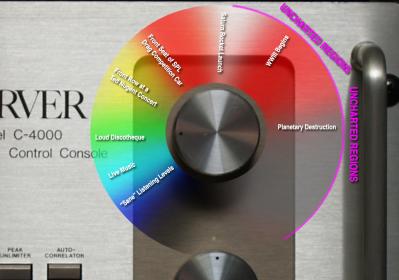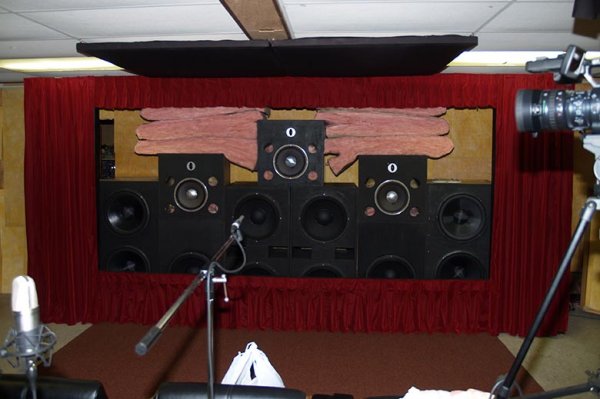READING RED TEA LEAVES
Hello again, I’m checking in for some more adventures.
Here I am going over the latest two MATT printouts. So refer to them as I go through this project. We’ll start with Mark, the bass pig and end with Gary, the MaggiStax guy.
It should be very clear that Mark the bass pig it hot and articulate in the bass range, below middle C, 260 Hz.
He is maintaining 20 dB articulation down to 250 Hz, when the listening position goes into a self cancel. Something seriously reflective is beaming the direct signal into the listening location with a time delay that equals ½ cycle of 250 Hz. That’s about 27”. If his listening position is 27” away from the back wall, that would do it.
Notice how the articulation remains strong all the way to 28 Hz. Even there it is about 5 dB. This is a fantastically clear room, the way pro recording studios are.
Fletcher Munson Curve
Except for one thing, which may be related to the nick name; “bass pig”. The bass just climbs in level, up to +10 dB over the midrange program material. Now, if we are playing the room quietly, this is an appropriate gain in the bass, as noted by the Fletcher Munson curve, which show us that our perception of bass is not as sensitive as our perception of midrange, at low sound levels. However at high sound levels we hear bass just as well as the mids. It’s as if bass pig is running his system with the bass boost button pushed all the way in.
This brings up a very interesting psychoacoustic fact. Our overall dynamic range in the midrange is about 100 dB, conversationally speaking. However, in bass it is only 50 dB. Our threshold of hearing in the treble range is 0 dB. Our threshold of hearing in the bass range is (hold your breath…) 50 dB. Yes, unbelievably 50 dB.
When we adjust volume, we adjust the entire bandwidth the same number of dB at the same time. If we were playing 100 dB and turned the volume down 10 dB, all frequencies drop 10 dB. That’s what we would expect a volume knob to do. But if we turn the volume down an additional 40 dB, we no longer hear bass, but our treble is still cooking at conversational sound levels.
In my former life (young), I built boxes for the first half of my life. I gave some away, lost a good number on (permanent) loan and sold some, usually for just enough to pay for the materials and drivers. I’d be doing the same thing today if I didn’t have a financially minded business partner. Anyway, I developed a great sounding low volume speaker. It had a small bass driver with a huge magnet and a big sealed box. It played the deepest bass quietly and had mid and tweet drivers that played clearly and quietly. It was made to produce quiet full range background music. But it sure sounded awful when the volume was turned up.
I always wondered why we don’t have a progressive volume control, one that keeps the apparent volume constant full bandwidth, instead of a simple linear one that we normally are provided with. It would be adjust bass between 100 and 50dB while it adjusted treble between 100 and 0 dB. I know there are some like that. Anyone have experiences with that type of volume control?
Let’s look at Gary -2, the guy with MagnapanStax headphones. He retook the MATT test after the idling truck drove off. However he reports after 40 seconds into the test another truck buzzed by him, but not for long. The test is 90 seconds. The center line of the test is 45 seconds into the test. Gary had a drive-by event a little before the center line of the test. What that event did is to raise the background noise floor, which means the room didn’t get as quiet as it otherwise would have gotten.
We have always kept the MATT test a symmetric test. Why? It is so comfortable to work with. Ascending tones followed by descending tones. If you hear it on the way up, you should also hear it on the way down. It’s like a double check on what you are hearing. Also, visually, it is just easier to see stuff when it is symmetrically displayed. We have tried many times to just show the first 45 seconds, the first half of the test, but it always leaves a hunger for completion.
The demo part of the MATT trainer is a good example of a half test.
http://www.acousticsciences.com/matt.htm
Anyway, look at the lowest portion of the test data, and keep comparing the left to right versions, which should be like a reflection. Between 625 and 700 Hz we can compare the data at 40 seconds in. Notice the flat bottom on the left section of data compared to the down, up down sculpted version of data on the right side? OK, it’s a fine point and barely noticeable, but when ever we see a flat bottom to the test, it’s usually noise.
Moving on. Overall, the levels are fairly flat and the intelligibility is fairly good (10 to 15 dB). We do see a lot of loud quiet loud quiet loud quiet etc a we move up the spectrum. This is typical of a reflective room. Now the bottom end is something else. We have a strong dropoff in level starting at 150 Hz and ending at 80 Hz. It climbs back up and hangs in there until it starts to roll off at 35 Hz. Notice the drop in articulation in the deep bass range, it’s down to 5 to 10 db. Even so, it’s pretty good.
What I don’t like is the notable amount of sonic gargling going on between 50 and 100 Hz. This should be an audible and bothersome affect. Again, I’d say your room is just too bright. Now I’ll go and try to find a picture of your setup… got it. Way too much side to side energy. We need to get some serious acoustics on your side walls.
You do not want any flutter energy anywhere near the area of the speakers. And I’ll bet there is a lot of flutter there. Stand near the speakers, facing the listening position. Clap your hands in front of you and again over your head. Hear that zing? That continuance of sound. What ever goes on in the front of the room is what you hear in your chair.
Carpet Acoustics
Here’s a good opportunity to slightly discuss acoustic ceiling tile. They are a directional acoustic product. They absorb vertical sound and do not absorb grazing sound. That means between the carpet and ceiling you probably do not have strong treble flutter, vertically, but the side walls….ouch….don’t get absorbed by those tiles up there.
Also, pull that carpet forward. You want the speakers playing off the 2 front corners of your magic carpet ride. And place your chair at the other end of the carpet. Persian carpets are acoustics for the floor. Notice, I’m not talking about any carpet, I’m talking about a Persian carpet. I have a white paper somewhere about carpets…
I was in a dealers showroom, on the east coast, someone who everyone knows. Very tricked out room with monster Wilsons. It was just awful and no one could figure out what was wrong. It was now my turn. I go up to the old boy and clap my hand. I hear the zinger. How could that be? Wall acoustics everywhere, TubeTraps in the corners and pressure zones of the walls. New carpet.
The only thing hot was the ceiling. It’s hard to get people to believe that sound has no sense of direction. They love to load stuff onto the side walls but can’t imagine that the ceiling is just like a side wall, as far as how a sound wave operates. Acoustically, a ceiling is a wall turned sideways. If you don’t see it like that…what can I say.
Back to the story: Clap – zing, clap – zing. I look around and there is no obvious repetitive sound path. So I look past the obvious. I can’t hear the zing side to side or front to back. It must be vertical, but we have fluffy new carpet. I get on all 4s and like a dog put my face close to her floor, sometimes I’ll just lay down to do this. And I say into the carpet the old sound check routine…check, check, testing one, two… I just as well could have been talking to a wall. It was so hot, yes the carpet. So I dig around and shine my flashlight into the carpet and it shines right back.
They had bought a new carpet, one that was sealed water tight, easy to clean and quick to dry after a steam cleaning. You know, I had written for those guys a paper about carpet selection and it was still sitting there in their acoustic file. But they forgot to read it before they went shopping and bought the wrong new carpet. I told them to drag a good Persian into the room and up to the front of the Wilsons and presto, they sounded like Wilsons.
Why do I always tell stories.....?
Hope you don’t mind…I just love life in the fast lane of audio, I know you guys do too.
Art Noxon
Invented TubeTraps, Pres of ASC
www.acousticsciences.com


